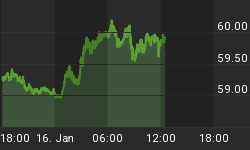The following is excerpted from a commentary originally posted at www.speculative-investor.com on 19th January 2014.
The US monetary inflation rate continues its downward drift. As at the end of December the year-over-year (YOY) rate of growth in US True Money Supply (TMS) was 7.2%, its lowest level since November of 2008. Refer to the following chart for details.

Last year's slowdown in US monetary inflation, from 11.4% at the beginning of the year to 7.2% at the end of the year, happened despite aggressive money-pumping by the Fed. That the rate of money-supply growth slowed materially in parallel with the Fed's aggressive monetisation program is partly because of money leaving the US. However, the main reason is illustrated by the chart displayed below.
The chart shows that US commercial bank credit expanded by only 1.2% last year. To put this into perspective, the only time over the past 50 years that total US commercial bank credit expanded at a slower pace than it did last year was in the immediate aftermath of the 2008-2009 global financial crisis and recession. It is also worth pointing out that the highest rate of growth in commercial bank credit over the past four years was only slightly above the LOWEST rate of growth during the 40-year period ending 2007.

The lack of much growth in commercial bank credit is consistent with our expectations. It is reasonable to expect that bank credit will continue to grow at an unusually -- by historical standards -- slow pace, because most banks are likely to remain risk averse for years to come.
The idea that the huge "excess reserves" of the banking system will prompt the banks to ramp up their lending is a non-starter. As explained in previous commentaries, there is no relationship between the amount of bank lending and the level of "excess reserves". The idea that the Fed could prompt the banks to ramp up their lending by reducing the interest rate paid on reserves is also a non-starter, for two inter-related reasons. First, bank lending does not have any effect on the quantity of reserves; it can only change whether reserves are classified as "required" or "excess". Second, the Fed currently pays the same interest rate on all reserves, regardless of whether they are classified as "required" or "excess".
If it wanted to, the Fed could force the banks to expand credit at a faster pace. One way it could do so would be to penalise the banks for holding "excess" reserves by levying a charge on these reserves. However, there is almost no chance of the Fed taking such an action. It should always be kept in mind that the Fed exists to support the banks, not to make life difficult for them.
The upshot is that commercial bank credit expansion will likely continue at a subdued pace, leaving the Fed as the dominant creator of new US dollars. This is a big change from the pre-2008 world, when almost all new money was loaned into existence by commercial banks.
One implication is that the Fed's "tapering" probably won't run its planned course. If the monetary inflation rate keeps falling then by the middle of this year there will be enough weakness in the US stock market and economy to cause the Fed to increase, rather than to reduce, its 'monetary accommodation'.
We aren't offering a free trial subscription at this time, but free samples of our work (excerpts from our regular commentaries) can be viewed at: http://www.speculative-investor.com/new/freesamples.html
















